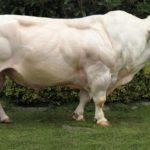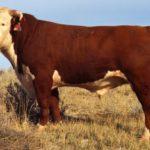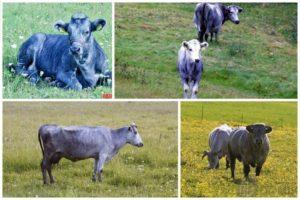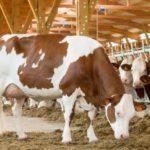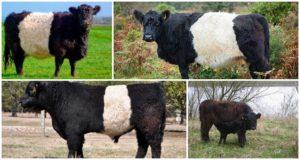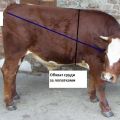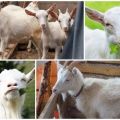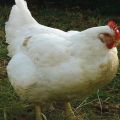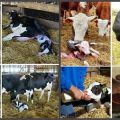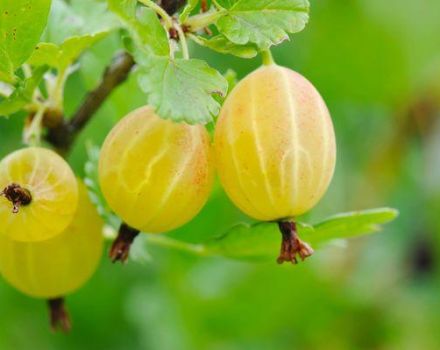Top 10 largest breeds of cows in the world and the size of the record holders
For farmers, the meat and milk productivity of cattle is important, but there are individuals that cause admiration not for slaughter weight and high milk yield, but for body dimensions. The largest cow in the world, weighing more than 1000 kg, was included in the Guinness Book of Records. The existence of giant animals was made possible by careful selection. Almost all of the breeds listed in the rating are bred in Russia.
Description and characteristics of the largest breeds of cows
A big cow is the pride of not only the farmer, but also the country. The admirable animals are bred not only for slaughter, milk production and breeding, but also for exhibition purposes.
The table shows the ranking of the largest breeds by body weight of adult animals.
| Ranking place | Breed name | Weight, kg |
| 1 | Chianina (Kian) | more than 1000 |
| 2 | blue belgian | 900 |
| 3 | hereford | 800-850 |
| 4 | bestuzhevskaya | 800 |
| 5 | Kostroma | 800 |
| 6 | Holstein | 700-750 |
| 7 | charolais | 700-750 |
| 8 | Montbéliard | 600-650 |
| 9 | Tagil | 550-600 |
| 10 | Angler | 550 |
Chianina
An Italian meat breed that has existed since the days of Ancient Rome. Bred by the inhabitants of the Italian valley of Val di Chiana, popular in South America, Canada. The growth of an adult cow at the withers reaches 1.6 m, the length is 1.7 m. The chest is voluminous, the withers are prominent, on the neat head there are short horns. Calves are born large, weigh 45-50 kg, develop rapidly, eat 2 kg per day. The color of adults is beige, sometimes with a yellowish tinge. Newborn calves are red, brighten as they grow. Due to the complex nature and tendency of the Italian cow to attack, she has to saw off the horns.
Belgian blue
Large beef cow bred in Belgium in the 18th century. The progenitors are Frisian and Shorthorn animals. In the 19th century, to increase the meatiness of the representatives of the Belgian breed, they were crossed with French Charolais. A frightening look caused by mutational muscle hypertrophy, the cow has recently acquired. The color is predominantly light blue. There is almost no hair, the skin is thin, covering the bulging muscles.
The only drawback is the exactingness of care and maintenance. Therefore, the large Belgian breed is popular in Western European countries, while in Russia it is still considered exotic.
Hereford
The breed popular on all continents is especially in demand in North America, Australia, Kazakhstan. A large deep red cow was bred by the British in the 18th century. Livestock came to Russia from England in the 1930s; today, Hereford cows are in second place in our country in terms of demand among beef breeds. The cows are short, stocky, with voluminous sides. White horns with black tips are directed forward. A newborn calf weighs from 30 kg.
The only negative is the exactingness of the conditions of detention.
Bestuzhevskaya
A large breed of meat and dairy orientation was bred at the end of the 18th century on the farm of the nobleman Bestuzhev in the Simbirsk province. Today there are large livestock in Bashkortostan, Samara, Ulyanovsk regions. The pet's body is powerful, the chest is voluminous, the back is straight. The coat is a deep red color, in some animals it is decorated with white spots.
Kostroma
The large beef breed was bred in Kostroma in the 1940s after lengthy breeding activities aimed at increasing the productivity of local animals. The cow, which is considered the best in Russia in terms of meat productivity, is distinguished not only by its large body, but also by good milk yield. It is inferior to foreign breeds in terms of productivity, but is popular with Russian farmers for its adaptation to local climatic conditions. The color of the cow is brown-gray or deep brown. A remarkable feature of the breed is the individuality of the character of each individual.
Montbeliard
A hardy, unpretentious, highly productive cow was bred by Swiss breeders. Breeding activities began in the 18th century, then the animals were transported to France, where the improvement of breed qualities continued. In 1889, the Montbeliard cow was shown at the World Exhibition in Paris.
In France, the breed is mainly bred by farmers in the foothill and mountain regions. Cows are beautiful, stately, classic spotted color, are considered elite, popular in countries where the production of beef and high-quality dairy products is flourishing.
Due to their attractive appearance and harmonious physique, representatives of the breed are often used on the set of advertising for dairy products.
Charolais
The large beef cow was bred in France in the early 19th century by crossing Shorthorn and Simmental animals. Today, there are numerous livestock in hundreds of countries around the world.
In terms of body size, representatives of the breed compete with their Kian relatives. The growth of an adult pet at the withers reaches 155 cm, length - 220 cm.The weight of a newborn calf is over 30 kg, and some calves are born with a weight of 50-60 kg. The color is beige, the body is massive, heavy, with developed muscles. The horns are of medium length.
The only drawback is sensitivity to temperature fluctuations. The cow has thick muscle mass, but a thin layer of fat under the skin. The animal experiences discomfort in cold weather, gains little weight. Therefore, the breed is kept exclusively in warm climatic regions.
Holstein
A large breed was developed in the USA in the 19th century through many years of painstaking selection. The classic black and white Holstein cow quickly became popular on all continents not only for its impressive body size, but also for its high milk yield. The most numerous livestock in Israel, where animals, thanks to the optimization of care and maintenance, are distinguished by the highest productivity.
The only negative is the exactingness to the conditions of detention and the quality of feeding. Holstein cows are squeamish and clean, should live in a warm, lighted, spacious barn, where there are no drafts.
Angler
The Germans bred a hardy brown-red cow on the Angeln Peninsula in the 1600s. The crossing involved productive Shorthorn animals. The result is a large cow with high beef and dairy production. In Russia, German cows ended up in the early 19th century. Today there are large livestock in Germany, USA, Russia.
The Angler pet has the best quality skin in the world, it is used in furrier business, it is suitable for creating expensive leather goods.
The only negative is the restive nature of individual individuals.
Tagilskaya
The large breed was developed in the 19th century by crossing Ural animals with Dutch cows in order to improve body structure and milk production. Tagil pets are both meat and dairy, the former are more popular. The cow is stocky, short, but massive, with a strong skeleton and developed chest. Any color, but black and white individuals are more common.
The largest individuals in the world
Among the large cows, there are record holders listed in the Guinness Book, which cause admiration and amazement for their dimensions. In the US state of Illinois, there is a cow named Blossom, which in 2016 was named the tallest on the planet. Neighbors urged owner Patty Hanson to donate her sterile, non-dairy cat to the slaughterhouse. But the hostess fell in love with the cow, in which she invested a lot of effort and money, she believed that she would become famous. And so it happened, the record-breaking cow weighs 900 kg, and is 1.93 cm tall.
In the English county of Dorset, another record holder lives - the heaviest cow - Rio, weighing 1250 kg with a height of 1.8 m.
It is also barren and unproductive, but attracts crowds of tourists to the farm. Rio has a complex and capricious character, the owner had to saw off her horns so that she would not harm the numerous visitors to the farm. Pitomitsa has grown exclusively on natural food, her diet does not include hormones and supplements for gaining mass.
Large cows are the result of painstaking selection and care of the owners. Bred with the aim of obtaining more milk and meat, they have become a pride and a living landmark in their countries of origin.



